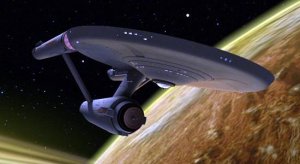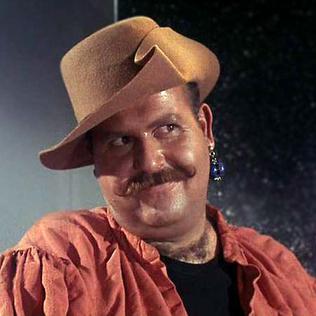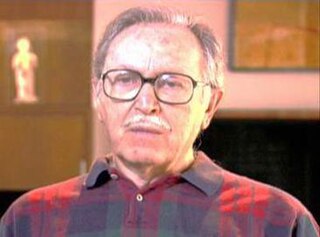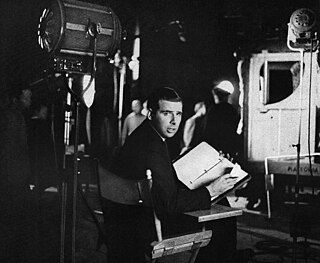
Eugene Wesley Roddenberry Sr. was an American television screenwriter and producer who created the science fiction franchise Star Trek. Born in El Paso, Texas, Roddenberry grew up in Los Angeles, where his father was a police officer. Roddenberry flew 89 combat missions in the Army Air Forces during World War II and worked as a commercial pilot after the war. Later, he joined the Los Angeles Police Department and began to write for television.

Majel Barrett-Roddenberry was an American actress. She was best known for her roles as various characters in the Star Trek franchise: Nurse Christine Chapel, Number One, Lwaxana Troi, and the voice of most onboard computer interfaces throughout the series from 1966 to 2023. She married Star Trek creator Gene Roddenberry in 1969. As his wife and given her relationship with Star Trek—participating in some way in every series during her lifetime—she is sometimes referred to as "the First Lady of Star Trek".
"The Cage" is the first pilot episode of the American television series Star Trek. It was completed on January 22, 1965. The episode was written by Gene Roddenberry and directed by Robert Butler. It was rejected by NBC in February 1965, and the network ordered another pilot episode, which became "Where No Man Has Gone Before". Much of the original footage from "The Cage" was later incorporated into the season 1 two-part episode "The Menagerie" (1966); however, "The Cage" was first released to the public on VHS in 1986, with a special introduction by Gene Roddenberry, as a hybrid of the color footage that was used in "The Menagerie" and black and white footage which was not used in "The Menagerie". It was not broadcast on television in its complete all-color form until 1988. The black and white version and all-color version were also released in various standard-definition media including LaserDisc, VHS, and DVD formats.

"Where No Man Has Gone Before" is the third episode of the first season of the American science-fiction television series Star Trek. Written by Samuel A. Peeples and directed by James Goldstone, it first aired on September 22, 1966.

Christine Chapel is a fictional character who appears in all three seasons of the American science fiction television series Star Trek: The Original Series, as well as Star Trek: The Animated Series and the films Star Trek: The Motion Picture and Star Trek IV: The Voyage Home. Portrayed by Majel Barrett, she was the ship's nurse on board the Starfleet starship USS Enterprise. A younger version of Chapel appears in the 2022 series Star Trek: Strange New Worlds, portrayed by Jess Bush.

USS Enterprise (NCC-1701) is a starship in the Star Trek media franchise. It is the main setting of the original Star Trek television series (1966–69), and it is depicted in films, other television series, spin-off fiction, products, and fan-created media. Under the command of Captain James T. Kirk, the Enterprise carries its crew on a mission "to explore strange, new worlds; to seek out new life and new civilizations; to boldly go where no man has gone before." Star Trek: Strange New Worlds (2022–present) depicts the Enterprise under the command of Kirk's predecessor, Captain Christopher Pike.

Janice Rand is a fictional character in the American science fiction television series Star Trek: The Original Series during its first season, as well as three of the Star Trek films. She is the Captain's yeoman on board the USS Enterprise (NCC-1701), and first appeared in the episode "The Man Trap". She had significant roles in the episodes "The Enemy Within", where she fights off an evil version of Captain James T. Kirk; "Charlie X" where a young man with god-like powers falls in love with her; and "Miri" where she is infected with a deadly disease while on an away mission and is kidnapped by jealous children.

Una Chin-Riley, commonly and originally only known as Number One, is a fictional character in the science-fiction franchise Star Trek. She is Christopher Pike's second-in-command during his captaincy of the starship Enterprise.
"The Man Trap" is the first episode of season one of the American science fiction television series Star Trek. Written by George Clayton Johnson and directed by Marc Daniels, it featured design work by Wah Chang and first aired in the United States on September 8, 1966.

"Mudd's Women" is the sixth episode of the first season of the American science fiction television series Star Trek. Written by Stephen Kandel, based on a story by Gene Roddenberry, and directed by Harvey Hart, it first aired on October 13, 1966.

Dorothy Catherine Fontana was an American television script writer and story editor, best known for her work on the original Star Trek series.
The "Theme from Star Trek" is an instrumental musical piece composed by Alexander Courage for Star Trek, the science fiction television series created by Gene Roddenberry that originally aired between September 8, 1966, and June 3, 1969.

Robert Harris "Bob" Justman was an American television producer, director, and production manager. He worked on many American TV series including Lassie, The Life of Riley, Adventures of Superman, The Outer Limits, Star Trek, Mission: Impossible, Search, and Then Came Bronson.
Herbert Franklin Solow was an American motion picture and television executive, screenwriter, motion picture and television producer, director and talent agent.
Star Trek is an American science fiction media franchise created by Gene Roddenberry, which began with the eponymous 1960s television series and became a worldwide pop-culture phenomenon. Since its creation, the franchise has expanded into various films, television series, video games, novels, and comic books, and it has become one of the most recognizable and highest-grossing media franchises of all time.

The first season of the American television science fiction series Star Trek: The Next Generation commenced airing in broadcast syndication in the United States on September 28, 1987, and concluded on May 16, 1988, after 26 episodes were broadcast. Set in the 24th century, the series follows the adventures of the crew of the Starfleet starship Enterprise-D. It was the first live-action television series in the franchise to be broadcast since Star Trek: The Original Series was cancelled in 1969, and the first to feature all new characters. Paramount Television eventually sought the advice of the creator of Star Trek, Gene Roddenberry, who set about creating the new show with mostly former The Original Series staff members. An entirely new cast were sought, which concerned some members of The Original Series crew, as Roddenberry did not want to re-tread the same steps as he had in the first series to the extent that well-known Star Trek aliens such as Vulcans, Klingons and Romulans were banned at first.

Eugene Wesley "Gene" Roddenberry was an American television screenwriter, producer and futurist best remembered for creating the original Star Trek television series. While at Los Angeles City College, he entered into a relationship with Eileen-Anita Rexroat, whom he went on to marry on June 20, 1942, before his deployment in the United States Army Air Corps during World War II. The couple had two daughters together, Darleen Anita and Dawn Allison. He joined the Los Angeles Police Department, and during this time he was known to have had affairs with secretarial staff, thus endangering his marriage.
Lincoln Enterprises, formerly Star Trek Enterprises, was a mail-order company set up by Bjo Trimble and Gene Roddenberry to sell merchandise related to the American science fiction television series Star Trek. It was known for selling official scripts and film cells directly from Desilu Productions during the run of the series. It later expanded into general Star Trek merchandise under Majel Barrett, and has since been subsumed into Roddenberry.com.

The development of Spock, a fictional character first introduced in the American science fiction television series Star Trek, began prior to the start of the series. The first known mention of Spock was in a discussion between Gene Roddenberry and Gary Lockwood, where the latter suggested Leonard Nimoy for the role. Roddenberry agreed with the suggestion, and Nimoy became the first choice actor for the part. However, Roddenberry was required to audition other actors for the role. It was offered to both DeForest Kelley and Martin Landau before Nimoy. Nimoy disliked the prosthetic ears he was required to wear, and there were concerns from the studio that they made him appear satanic. Roddenberry fought to keep the character in the second pilot, "Where No Man Has Gone Before" after the rest of the main cast was dropped from the initial pilot, "The Cage".













